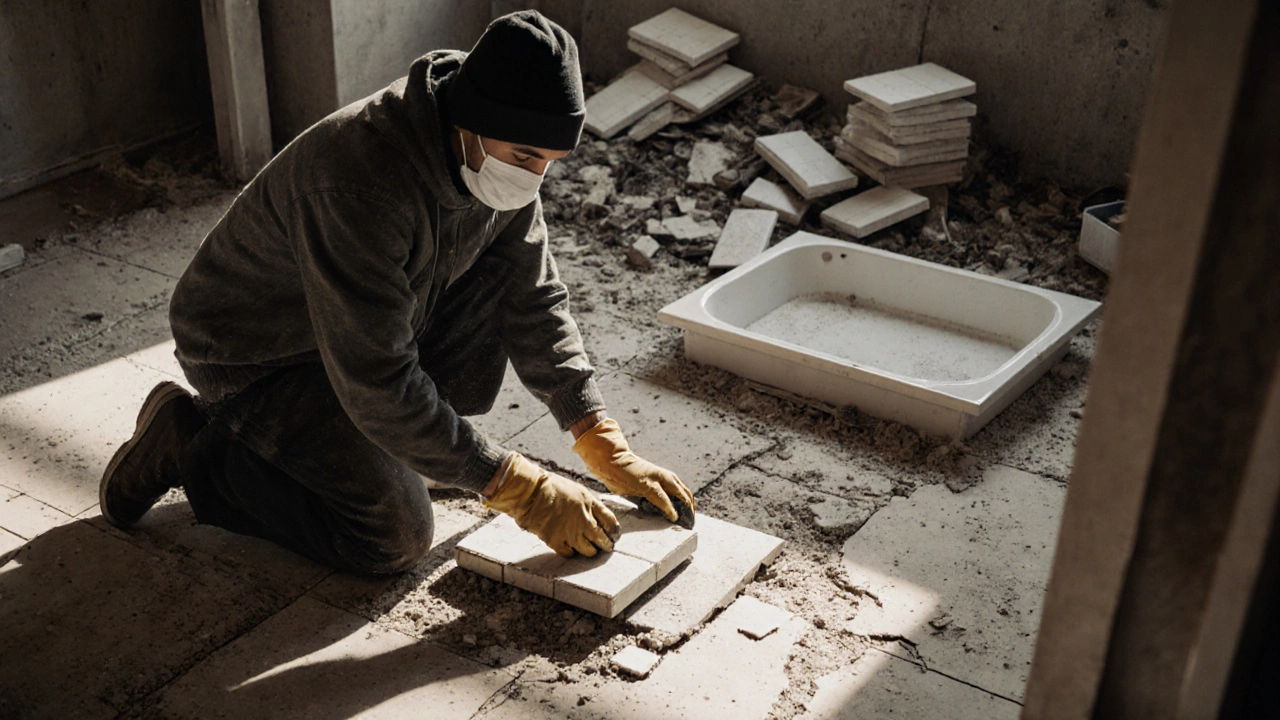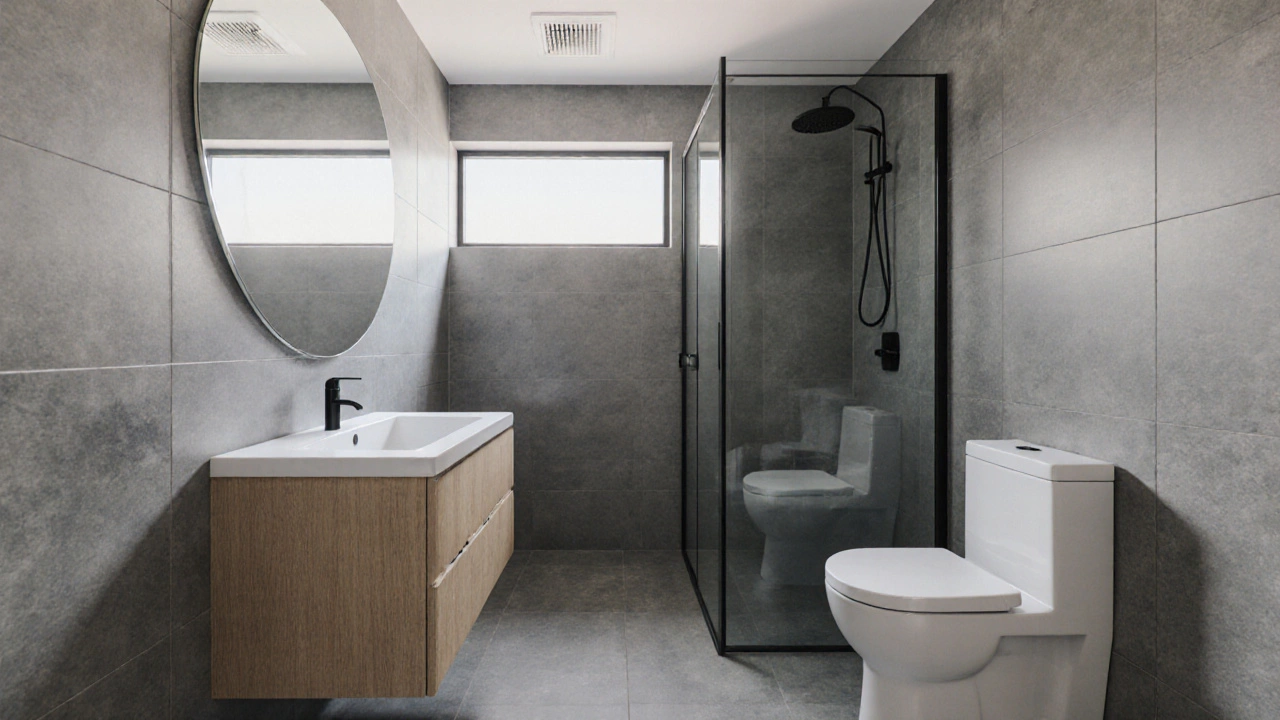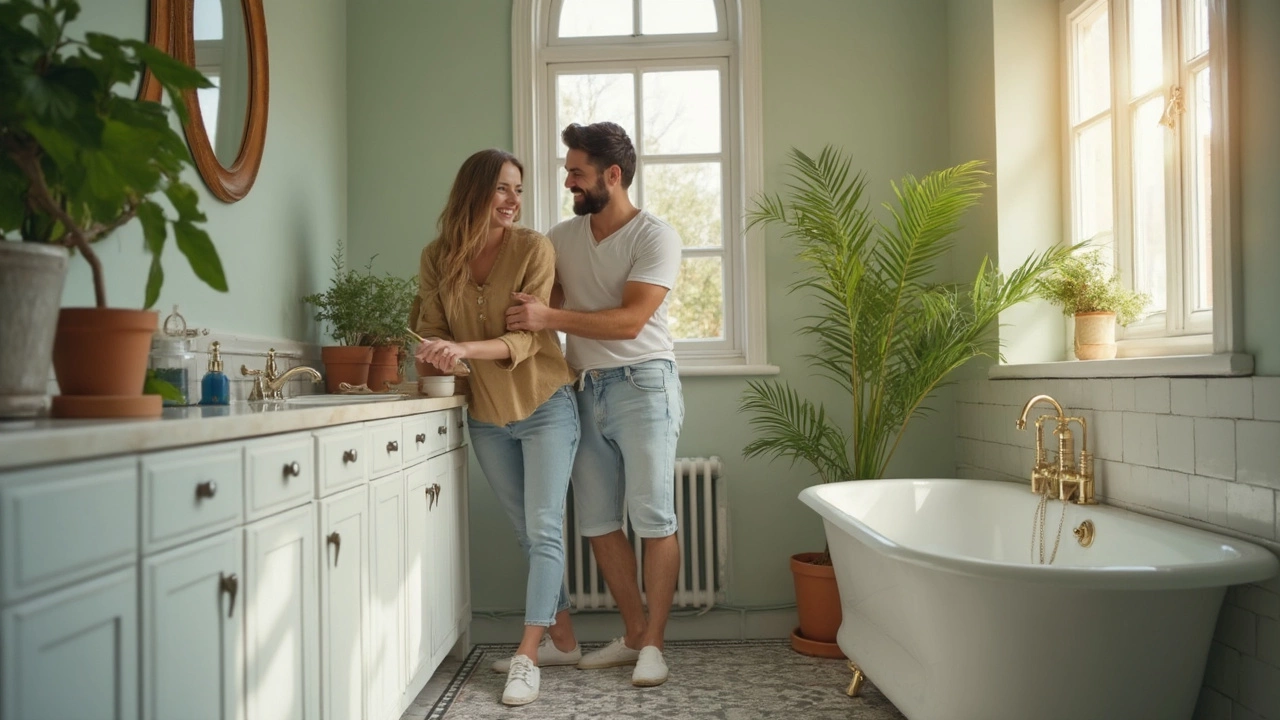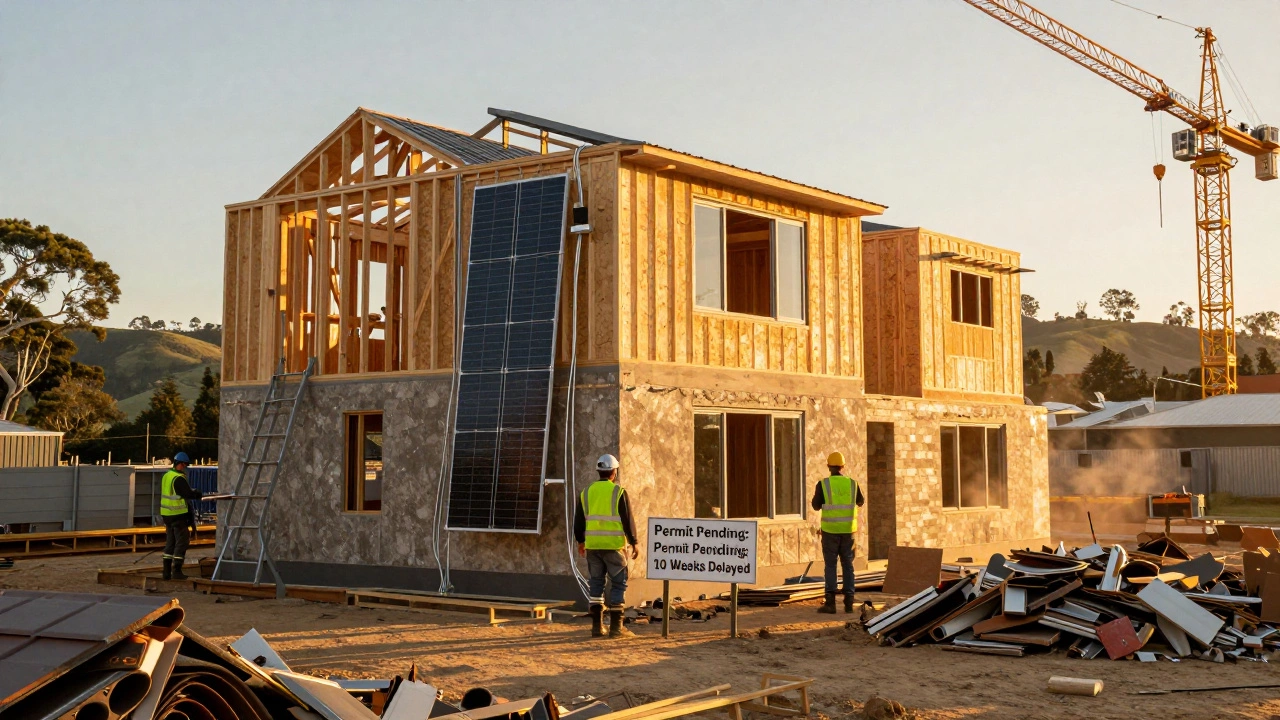Bathroom Renovation Budget Calculator
Calculate Your Budget
Enter your renovation choices to see if you can stay under $10,000 in 2025 Australia
Choose Your Features
Budget Breakdown
Tip: The article suggests saving on tiles, vanities, and lighting while prioritizing waterproofing and the shower tray.
Can you really renovate a bathroom for $10,000? In 2025, with material prices still above pre-pandemic levels and labour shortages lingering, that question keeps popping up in Melbourne kitchens, Facebook groups, and Reddit threads. The short answer? Yes - but only if you know where to cut, where to spend, and what to avoid. This isn’t about buying the cheapest tiles or skipping the waterproofing. It’s about making smart, strategic choices that deliver a bathroom that looks new, works well, and lasts.
What $10,000 Actually Buys in a Bathroom Renovation
A $10,000 budget for a full bathroom renovation in Australia in 2025 means you’re working in the mid-low range. For comparison, the average bathroom remodel here runs between $15,000 and $30,000. So you’re not doing a luxury spa retreat. But you’re not stuck with a 1980s avocado tub either.
Here’s what a realistic $10,000 budget can cover in a standard 4m x 3m bathroom:
- Fixtures: A modern wall-hung toilet, a single-sink vanity with basin, a shower tray with glass screen, and a basic overhead showerhead - all from brands like Reece, Caroma, or Bunnings’ own range. Expect $2,500-$3,500 here.
- Tiling: Ceramic or porcelain tiles on walls and floor. You’ll use 600x600mm tiles on the floor and 300x600mm on walls. Avoid expensive natural stone. Stick to matte or textured finishes that hide grime. Budget $2,000-$2,800 including adhesive and grout.
- Plumbing: Relocating pipes is expensive. Keep the toilet, shower, and sink in their original spots. Moving a drain by even a metre can add $1,500+ to your bill. Budget $1,500-$2,000 for basic re-plumbing.
- Electrical: New lighting, a heated towel rail, and a GFCI outlet near the sink. Skip underfloor heating. Budget $800-$1,200.
- Demolition and waste removal: Removing old tiles, cabinetry, and fixtures. This is often overlooked. Budget $800-$1,000.
- Labour: A tradesperson who does plumbing, tiling, and electrical work can save you money. Look for a licensed handyman with multiple skills. Budget $1,500-$2,000. Don’t go cheap on waterproofing - that’s non-negotiable.
- Contingency: Always set aside 10% - $1,000 - for surprises like rotten subfloor or hidden mould.
That adds up. No room for luxury. No freestanding tub. No smart mirrors. But you can still get a bathroom that feels fresh, clean, and modern.
Where to Splurge and Where to Save
Not every part of the bathroom needs top-dollar materials. But some things? You don’t mess with them.
Splurge on:
- Waterproofing: This isn’t a place to cut corners. A bad waterproofing job leads to mould, rot, and structural damage. Pay for a licensed professional to apply a membrane, even if it eats up $1,000 of your budget. It’s the only thing that stops your ceiling from collapsing in 3 years.
- Shower tray and glass screen: A cheap shower tray cracks. A flimsy glass screen rattles and leaks. Spend $1,200-$1,800 here. A good tray with a slight slope and a 6mm tempered glass screen lasts decades.
- Ventilation: A quiet, powerful exhaust fan is worth every dollar. Mould grows fast in humid bathrooms. Install a 100L/s fan with a timer. It costs $300-$500 installed and prevents long-term damage.
Save on:
- Tiles: Avoid imported marble or large-format slabs. Stick to Australian-made ceramic tiles from Bunnings or Reece. You’ll find great options under $30/sqm. Textured or matte finishes hide water spots and are easier to clean.
- Vanity: Skip custom joinery. Go for a pre-made MDF or laminate vanity with a solid surface top. Bunnings’ ‘Bathstore’ range has decent options under $800. Add a basin and tap for another $400.
- Lighting: You don’t need LED strips and dimmable smart bulbs. A single ceiling-mounted LED panel with 5000K colour temperature gives bright, even light. Budget $150.
- Accessories: Towel rails, toilet paper holders, soap dispensers - buy these from IKEA or Amazon. They look fine and cost a fraction of designer brands.
What You Can’t Do on a $10,000 Budget
Be honest with yourself about what’s off the table.
- No moving walls: Structural changes or relocating plumbing drains will blow your budget. Keep everything in its original footprint.
- No freestanding tub: Even a small acrylic tub costs $1,500 alone. Add plumbing, tiling, and a custom surround? You’re at $5,000 before you even start.
- No underfloor heating: Electric systems cost $1,500-$2,500 to install. That’s 25% of your budget gone.
- No smart tech: Heated mirrors, voice-controlled lighting, or automated blinds? Save those for a future renovation.
- No custom cabinetry: Built-in shelves or floating vanities made from solid timber? Those are $3,000+ jobs.
If you’re attached to any of these, either raise your budget or reconsider your priorities. A $10,000 renovation is about function, not fantasy.
Real-Life Example: A Melbourne Bathroom Done for ,800
A couple in Footscray renovated their 1970s bathroom in June 2025. Here’s how they did it:
- Kept the toilet, sink, and shower in original positions - saved $2,200 in plumbing.
- Used Bunnings’ ‘Slate Grey’ 600x600mm tiles for floor and walls - $2,100 total.
- Installed a wall-hung Caroma toilet and matching vanity with basin - $1,400.
- Got a 1200mm x 900mm acrylic shower tray with 6mm glass screen - $1,600.
- Replaced old wiring and added a 100L/s exhaust fan - $900.
- Demolition and waste removal - $850.
- Licenced handyman for tiling, plumbing, and electrical - $1,800.
- Contingency fund used for replacing a rotten subfloor - $1,150.
Total: $9,800. No luxury finishes. No designer brands. But the bathroom now has clean lines, no leaks, and a modern look. The wife says, ‘It feels like we moved into a new house.’
How to Stretch Your $10,000 Even Further
Want to get more bang for your buck? Here’s how:
- Do the demolition yourself: If you’re handy, remove old tiles, cabinets, and fixtures. You’ll save $500-$800. Wear gloves, goggles, and a mask. Dust is nasty.
- Shop end-of-line stock: Reece, Bunnings, and local plumbing suppliers have clearance sections. You can find brand-new vanities, taps, and tiles at 40% off.
- Buy in bulk: Buy all your tiles from one supplier. You’ll get a discount and avoid colour mismatches.
- Time it right: Renovate in winter. Trade contractors are slower, so you might get better rates. Plus, you won’t need to rush for a summer deadline.
- Use a single tradesperson: Find someone who can do plumbing, tiling, and electrical. You’ll save on coordination fees and multiple call-out charges.

Common Mistakes That Blow the Budget
People think they’re saving money - then they’re not.
- Buying cheap tiles that chip: Low-grade tiles crack under pressure. You’ll be re-grouting in 2 years.
- Skipping waterproofing: One leak, and you’re paying $8,000 to fix the ceiling below. Don’t be that person.
- Choosing a vanity that’s too big: It might look nice in a showroom, but if it blocks the door or makes the shower cramped, you’ll hate it.
- Not checking for asbestos: Homes built before 1990 might have asbestos in old tiles or pipe insulation. Testing costs $300. Removing it? $2,000+. Better to know now.
- Going for ‘trendy’ finishes: Black taps and matte black fixtures look cool now. But they show water spots and fingerprints. Matte chrome or brushed nickel lasts longer and cleans easier.
Is $10,000 Enough? The Verdict
Yes - if you’re realistic. You won’t get a magazine-cover bathroom. But you can absolutely get a bathroom that’s safer, cleaner, more functional, and visually upgraded.
The key is planning. Sketch your layout. Measure everything. Visit suppliers. Get quotes. Know exactly what you’re getting for every dollar. And never, ever skip waterproofing.
For most Australian households, $10,000 is the sweet spot for a bathroom that lasts 15-20 years without needing another full renovation. It’s not glamorous. But it’s smart. And in the end, that’s what matters.
Can you renovate a bathroom for $10,000 in Australia?
Yes, you can renovate a bathroom for $10,000 in Australia in 2025, but only if you keep the layout the same, avoid luxury features, and prioritize waterproofing and essential fixtures. This budget covers basic tiling, a new vanity, toilet, shower, plumbing, and labour - but not moving walls, underfloor heating, or freestanding tubs.
What’s the cheapest way to renovate a bathroom?
The cheapest way is to keep plumbing and electrical in their original locations, use budget-friendly tiles from Bunnings or Reece, buy a pre-made vanity, and hire a single licensed handyman who does multiple trades. Do the demolition yourself to save $500-$800. Avoid custom joinery, smart tech, and natural stone.
How much does a bathroom renovation cost per square metre in Australia?
In 2025, a basic bathroom renovation costs between $2,000 and $3,500 per square metre. A $10,000 renovation for a 4m x 3m bathroom (12m²) works out to $830 per m² - which is at the low end of the scale. Luxury renovations can exceed $6,000 per m².
Is it cheaper to renovate a bathroom or replace it?
Renovating is almost always cheaper than replacing. Replacing means demolishing everything, rebuilding walls, relocating plumbing, and installing new fixtures from scratch. A full replacement can cost $20,000-$40,000. Renovating keeps the structure and only upgrades what’s visible and functional - saving you 50% or more.
What bathroom fixtures should you spend more on?
Spend more on waterproofing, the shower tray, the glass screen, and the exhaust fan. These are the components that prevent long-term damage. A cheap shower tray cracks. A weak fan causes mould. A bad waterproofing job ruins your ceiling. These are the three things that will save you thousands in future repairs.








